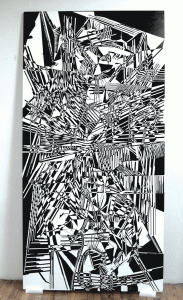« Reviews
Vargas-Suárez Universal - Cosmodrome Vectors

Vargas Suárez Universal, Cosmodrome Vectors, 2009, oil on formica panel 97” x 49”. © Vargas-Suarez Universal. Courtesy of the artist and Think21 Gallery.
Think21 Gallery - Brussels, Belgium
Curated by Lara Pan
A Trip to Baikonur with Vermeer
By Ekaterina Rietz-Rakul and Steve Schepens
Artists of the seventeenth century were fascinated with the development of science facilitated by the invention of the telescope and microscope. Scientists and the work they were undertaking became a subject of painting, and since then the interest of humanity towards the mysterious endless space surrounding their home planet has yet to fade.
Growing up in Houston, Texas, in close proximity the Johnson Space Center undoubtedly influenced Rafael Vargas-Suárez to study both astronomy and art history, eventually combining his knowledge and fascination of both fields in his work. His installations, wall drawings and paintings seem a result of intensive scientific-style research. In the beginning, Vargas-Suárez Universal was using various charts, architectural blueprints and other geological documentation almost exclusively from Houston. Over time, his installations became site-specific, dealing with the architecture and the history of the exhibition spaces; and the sources of his work became more personal as he decided to draw his inspiration from his own experience and imagination.
To create his works–large-scale wall paintings, installations, sound-installations and drawings–the artist utilizes different materials. His wall paintings, permanent or temporary, are made on real walls or their photographic reproductions. The artist paints and draws on pictures of buildings and fashion models, surfaces which are otherwise difficult to obtain as a canvas. In his Paris exhibition, though, VSU managed to make drawings on the face of a real model. This work reminds one of patterns for plastic or reconstructive surgery and relates to Angst caused by time and gravity.
The exhibition in the Think21 gallery, curated by Lara Pan, shows VSU’s kaleidoscopic and dynamic oil paintings, which create an illusion of being three-dimensional. They are painted–just like in the Middle Ages, Gothic and Renaissance–on wooden panels or their contemporary synthetic pendants– Formica panels and vacuumized aluminum thermal blankets on panels. The latter is a carrier for a series ????????? (El Dorado, 2009), which refers to the mythological land of infinite wealth– a legend extremely popular in the seventeenth century. Brought to Europe by the sea explorers in the sixteenth century, it was based on culture and legends of Natives. The shiny surfaces of the paintings, as well as the Russian title, seem to deal with the space race between Russia and the USA, as well as the fact that the cosmos becomes humanity’s new El Dorado.
One of the most important notions for VSU’s paintings is a vector. In Cosmodrome Vectors, the black and white abstract composition describes lively interaction of personnel, buildings and space machines. STS 126: E.V.A. 1 - 6Hrs 52Min, as well as the other works of this series, seem to be composed from the vectors of space walks. The latter might soon take place on humanity’s next home planet, whose topology is explored in the triptych Next Green Sphere. Obviously, the vector of our development points to the expansion of the universe. So are we anxiously standing on the launching platform of Baikonur, in the company of Johannes Vermeer and Vargas-Suárez Universal?
(January 22 - March 6, 2010)
Filed Under: Reviews


































